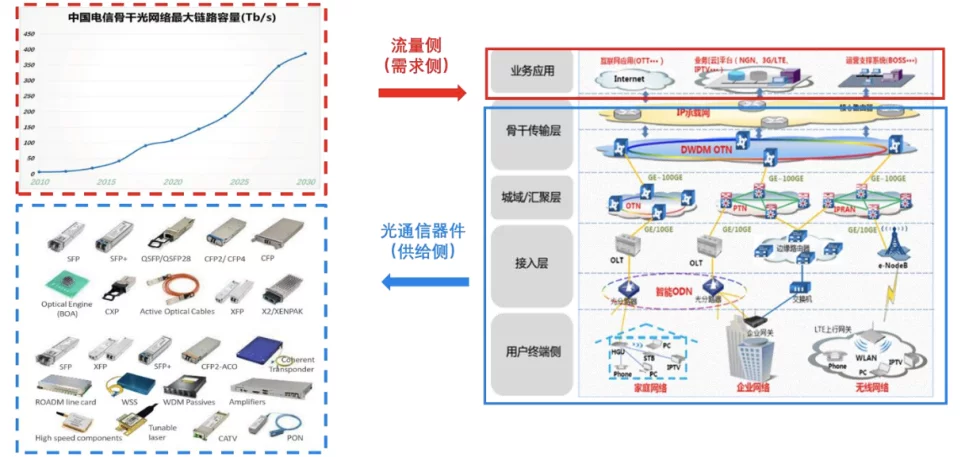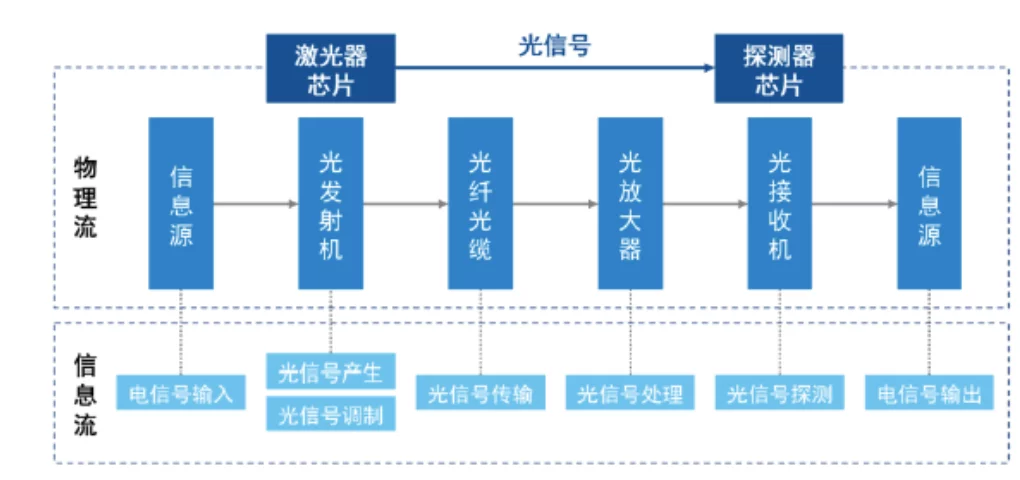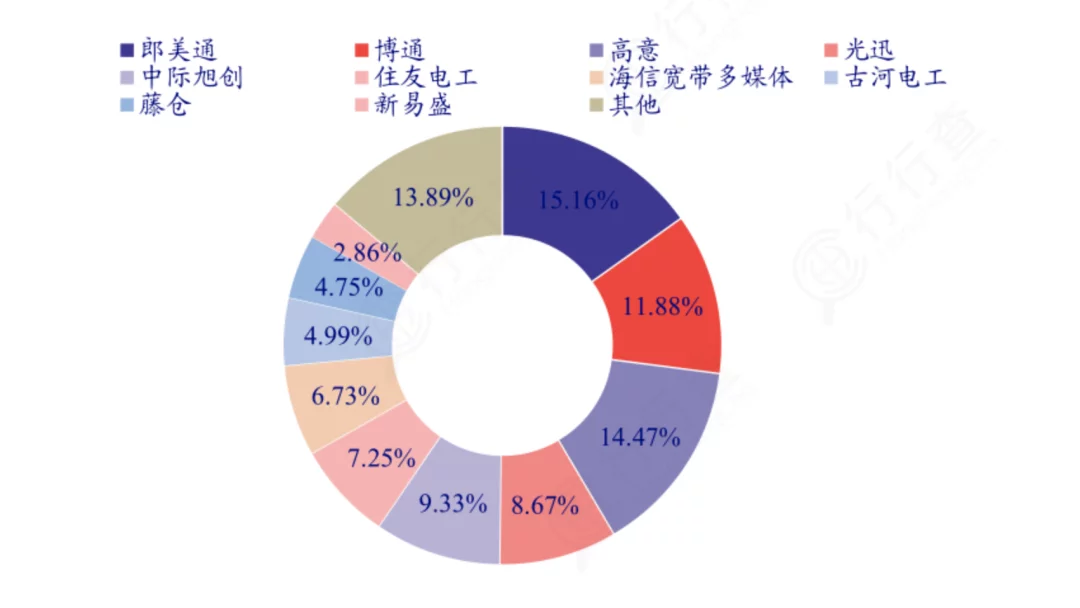A new wave of AI is sweeping the world, optical communication is the basic and solid foundation of AI computing power network the development of computational power networks has posed higher demands on backbone networks and large-scale data centers. The construction of the optical foundation for computational power networks urgently requires support from new types of optical communication products. The specific scenarios and business requirements encompass two aspects: first, backbone network transmission, and second, optical connectivity within large-scale data centers. In 2025, the scale of China's optical communication market is expected to reach 175 billion yuan, corresponding to 12% CAGR from 2022 to 2025.
Optical communication industry
Optical communication is a communication mode with optical signal as information carrier, which is developed on the basis of electrical communication. Compared with traditional electrical communication, optical communication has the advantages of huge transmission bandwidth, extremely low transmission loss, low cost and high fidelity. As an information infrastructure, optical communication system has been fully developed and widely used in the world.
The essential driving force of optical communication network construction is the rapid and continuously increasing demand for data traffic. After decades of updating and iteration, the market scale has been growing continuously. With the continuous growth of data traffic, the pressure of data transmission and bandwidth of traditional bearer network is increasing, and the transmission rate of backbone network will be upgraded from 100G to 200G/400G and other higher rates. Optical communication network technology industry chain is the supply side, and traffic growth is the demand side.

Figure 1: Development status of optoelectronic communication in China (* Data source: Ministry of Industry and Information Technology, Finisar)
Optical communication industry chain
Optical communication technology has been widely used for more than 20 years, and has formed a relatively mature industrial chain system in the world. The most upstream component suppliers, including PCB, optical chips, optical active devices, optical passive devices and so on. The midstream involves fully independent functional optoelectronic devices, including optical transceiver modules, optical amplifiers, optical transmission subsystems, etc. After the assembly and integration of optoelectronic devices, they form the communication equipment segment, ultimately delivered to network operators for use.

Figure 2: Optical communication industry chain
1、Optical chip
Optical chip is the basic component to realize photoelectric signal conversion, which can be further assembled and processed into optoelectronic devices, and then integrated into the transceiver module of optical communication equipment to achieve wide application. Its performance directly determines the transmission efficiency of optical communication system. Optical chips can be divided into laser chips and detector chips according to their functions. The laser chip is mainly used to transmit signals and convert electrical signals into optical signals, while the detector chip is mainly used to receive signals and convert optical signals into electrical signals.

Fig. 3: Application location of optical chip in optical communication system
From the perspective of the global optical chip market, overseas optical chip manufacturers have a first-mover advantage, while there is significant potential for domestic substitution in the high-end and mid-range optical chip segments. China's optical chip enterprises have generally mastered the core technologies of 2.5 G and 10G optical chips, but there are still some models with high performance requirements and great difficulty. The number of domestic manufacturers who realize batch supply is small, and there is a broad space for domestic substitution in the industrial chain. Domestic manufacturers mainly include YUANJIE Semiconductor Technology, Wuhan MINDSEMI, ZHONGKE GUANGXIN, GLSUN Sicence and Tech, AROPTICS, SHIJIA Photons, Elite Optronics and CETC.
2、Optical devices
In the middle-end optical module, the cost of optical devices accounts for 73%, and that of circuit chips accounts for 18%. The high cost of optical devices in optical modules is the core factor that determines the price of optical modules. The market for passive optical devices and the lower to mid-range segments of active optical devices are in a phase of intense competition, while the high-end active optical devices sector is in a state of relative complete competition
There are many optical device manufacturers in China, and the overall competition pattern is scattered, which is limited by the small scale of a single market segment and the small scale of revenue of most optical device manufacturers. This is mainly due to the high degree of customization in optical devices, requiring a significant amount of manual labor, making it challenging to achieve economies of scale. Most manufacturers focus on specific product categories, and there are relatively few companies with revenues exceeding 1 billion yuan. In addition, the manufacturing of different optical devices requires different equipment, and technology research and development also needs to be re-laid out, so most companies focus on several sub-sectors.
The characteristics of high technological barriers determine that if enterprises want to become bigger in a short time, mergers and acquisitions are quick methods. In recent years, acquisitions in the field of optical devices have occurred frequently. DVANCED FIBER RESOURCES acquired LUMENTUM lithium niobate high-speed modulator product line; CISCO Acquires ACACIA; MARVELL acquires INPHI; NOKIA acquired silicon light startup ELENION; ZHONGJI INNOLIGHT acquired TSUHAN; TFC Optical Communication acquired AUXORA The representative manufacturers in this link mainly include TFC Communication, ACCELINK Technology, SHIJIA Photons, BROADEX Technology, T&S Communications, CIG Shanghai, ADVANCED FIBER RESOURCES and HUAGONG Tech company.
3、Optical module
Optical modules are positioned in the midstream of the industry chain, with relatively high profit margins in the entire optical communication industry chain. It undertakes the task of signal conversion, and can make functions of optical signal generation, signal modulation, detection, optical path conversion, photoelectric conversion and so on. According to Yole data, the global market share of China's optical module manufacturers exceeds 40%, among which ZHONGJI INNOLIGHT, ACCELINK Technologies and EOPTOLINK are in the forefront of listed companies.
ZHONGJI INNOLIGHT 400G series related products have been gradually applied in domestic mainstream equipment manufacturers and Internet cloud vendors, which will effectively promote the construction of China's 5G and "Dongshu Xisuan” ("Dongshu Xisuan" is a comprehensive project that builds an integrated computing power network system involving data centers, cloud computing, and big data. It systematically guides the computing power demand from the east to the west, optimizes the layout of data center construction, and promotes collaborative coordination between the eastern and western regions.) ACCELINK technology is one of the optical device enterprises with the most comprehensive product coverage in the industry. The high-end optical modules produced include 400G, 800G series digital communication modules, 400G coherent optical modules and so on. EOPTOLINK provides cloud data center customers with products ranging from 100G, 200G, 400G to 800G. For telecommunications equipment vendors, and offers optical modules for 5G front-haul, mid-haul, and backhaul, as well as optical modules used in metropolitan area networks, backbone networks, and core network transmissions. Additionally, Xinyisheng delivers optical module solutions for smart grids and security surveillance network service providers.

Figure 4: Distribution Proportion of Global Optical Module Manufacturers (* Data Source: hanghangcah)
According to Lightcounting data, it is estimated that after 2022, although 100G optical modules are still the mainstream model in demand, with the continuous increase of capital expenditure of overseas cloud vendors, 200G/400G/800G silicon optical modules are expected to continue to undergo industry iteration, and the shipments of high-speed optical modules will increase greatly. Under the background of continuous growth of traffic, the demand for optical modules in the new power market and the digital communication market will continue to exist, and will be continuously updated and iterated at the technical level, thus driving the upstream optical device market demand to maintain steady growth.
4、Fiber optic cable
Optical fiber and cable are located in the lower reaches of the industrial chain, benefiting from the centralized acquisition of operators and the high demand of 5G. The upstream optical rod manufacturers of optical fiber cables make mandrel and outsourcing raw materials into optical rods, while the downstream optical fiber cable manufacturers make optical rods into optical fibers through wire drawing and other processes, and then produce one-core or multi-core optical cables according to requirements.
It is reported that optical fiber preforms account for 70% of the profits of the industrial chain due to high technical barriers to production, while optical rod fiber drawing and optical fiber cabling account for 20% and 10% of the profits of the industrial chain respectively due to relatively low technical and capital barriers and full market competition. According to CRU report, only about 20 manufacturers in the world have mastered the preparation process of optical fiber preforms, and the domestic optical rod production capacity is mainly concentrated in several leading manufacturers such as Yangtze Optical Fiber and Cable Joint Stock Limited Company, Zhongtian Technology, Hengtong Optic-Electric, Futong Information Science and Technology, FiberHome Telecommunication Technologies, Etern Company Limited and Tongding Interconnection Information.

Figure 5: Optical fiber and cable industry chain (* Data source: Bank check)
With the increase of traffic, the disadvantages of electronic devices such as bandwidth limitation, insufficient capacity and highly power consumption are highlighted, and the phenomenon of "electronic bottleneck" appears in the communication network. In order to solve this bottleneck, operators first adopt optical communication in backbone network lines, and gradually extend to metropolitan area networks, access networks and base stations. After the optical fiber circuit is completed, the concept of all-optical network is further put forward. Data is only converted into electro-optic and photoelectric when entering and leaving the network, and all the transmission and exchange processes in the network always exist in the form of light. The equipment in the network is upgraded from circuit switching to optical cross-connect data exchange with high reliability, large capacity and high flexibility.
At the key decision points for operators to deploy 400G, different modulation formats, optical modules, optical fibers, chips, WSS devices, etc. in future deployment schemes need different consideration standards, and there are investment opportunities in related fields. Mainly includes high-speed optical module light source: YUANJIE Semiconductor Technology, etc.; High-speed and long-distance telecommunication optical modules: TACLINK, EOPTOLINK, ZHONGJI INNOLGHT, TFC Optical Communication, ACCELINK Technology, etc.; OTN equipment: ZTE, FIBERHOME Telecommunications; G654. E optical fiber: Yangtze Optical Fiber and Cable Joint Stock, Zhongtian Technology, Hengtong Optic-Electric, jiangsu Etern company, etc.; WSS devices: ACCELINK Technology, Optowide Technology, etc.
However, the optical network also has shortcomings, first of all, the higher installation cost, because the installation requirements of optical fiber are strict, and the installation quantity of optical fiber network is also relatively large; Secondly, the maintenance cost of optical fiber network is high, because the maintenance quantity of optical fiber network is large and the equipment of optical fiber network is expensive.
In all-optical network, because there is no photoelectric conversion link and various protocols and coding forms are supported, the information transmission is transparent and the data transmission efficiency is further improved. At present, the backbone network and metropolitan area network of global operators have been fiber-optic, and the access network in some areas has been fiber-optic, and the evolution to all-optical network has begun.






